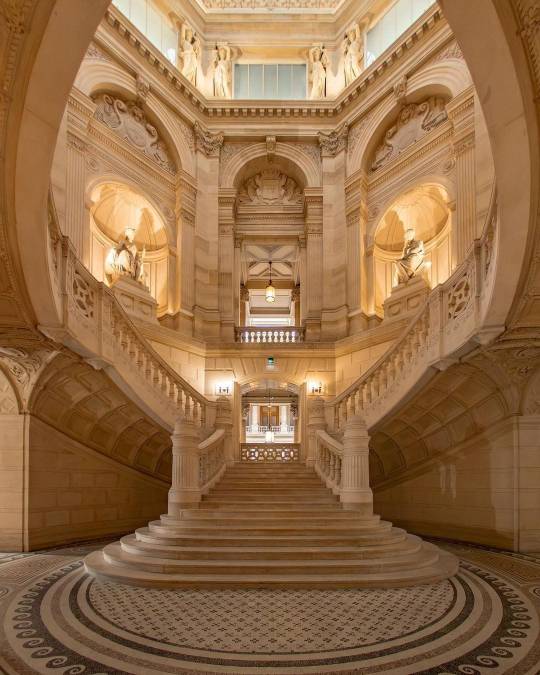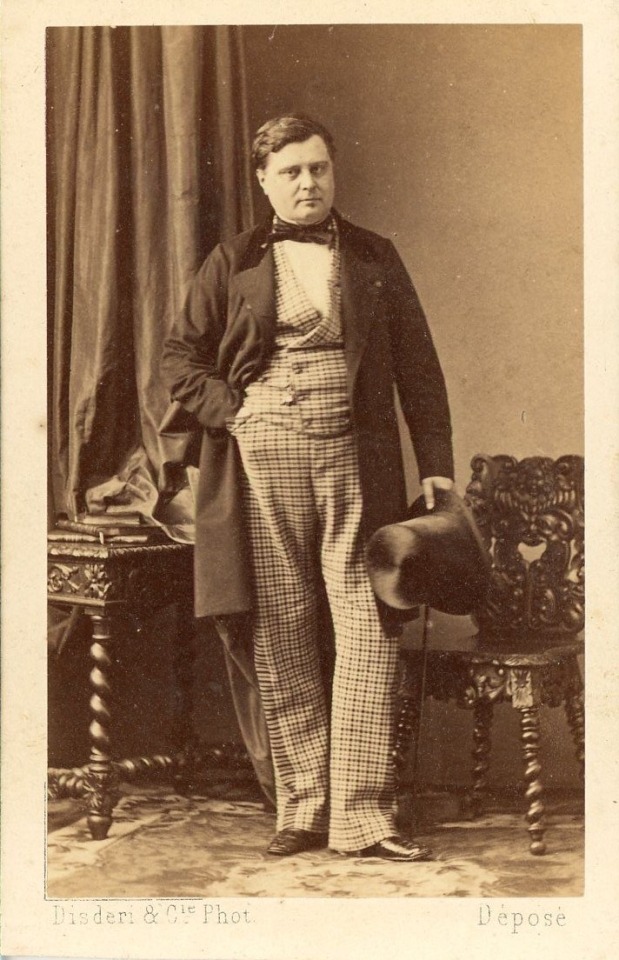#napoleon iii
Explore tagged Tumblr posts
Text

The courthouse building for the Tribunal de Commerce,
Paris, France,
Built between 1859 and 1865 on a design by architect Antoine-Nicolas Bailly, inspired by the Renaissance Palazzo della Loggia in Brescia. It was ceremoniously inaugurated by Napoleon III on 26 December 1865.
Credit: Bon Voyage Cleo
#art#design#architecture#history#style#interior design#grans staircase#courtgouse#paris#france#antoine-nicolas bailly#palazzo#palazzo della loggia#napoleon III#bonvoyagecleo
1K notes
·
View notes
Text

Print of Napoleon 1st appearing to his nephew, in his prison
60 notes
·
View notes
Text

Samuel Rayner, View of a French Style Drawing Room in a Townhouse, c. 1855, watercolor.
#samuel rayner#watercolor#19th century#19th century art#interior#paintings#london townhouse#london#interior design#second empire style#napoleon iii#second empire#drawing room#period design#victorian#nineteenth century interior#architecture#art#artwork#painting#design#british art#british design#english art#drawing#decor#period decor#victoria & albert museum#domestic interior
56 notes
·
View notes
Text






[T]he Franco-Prussian war was an expensive one; but it was worth to France all it cost her people. It was the completion of the downfall of Napoleon III. The beginning was when he landed troops on this continent. Failing here, the prestige of his name—all the prestige he ever had—was gone. He must achieve a success or fall. He tried to strike down his neighbor, Prussia—and fell.
Ulysses S. Grant, Personal Memoirs of U. S. Grant (1885)
The Franco-Prussian War, between the German Confederation and France, lasted six months from 1870 to 1871. The immediate consequences for the belligerents were considerable: on the one hand, the fall of the Second French Empire, the civil war of the Commune and the advent of the Republic; on the other, the creation of the German Empire under the aegis of Prussia.
From "French Army 1870-71 Franco-Prussian War: 2 Republican Troop"
#history#military art#1800s#military#soldier#france#napoleon iii#francoprussian war#french uniform#prussia#french history#german history
55 notes
·
View notes
Text

Queen Victoria in Cherbourg - Napoleon III receiving the Queen of England on board the ship La Bretagne, August 6, 1858 by, Antoine Léon Morel-Fatio, 1859
139 notes
·
View notes
Text

Prince Louis-Napoléon Bonaparte (son of emperor Napoléon III) by Alex Bassano, c. 1879.
#france#history#19th century#victorian#victorian era#1800s#1870s#napoleon#napoléon#napoleon iii#royalty#antique
240 notes
·
View notes
Text

Napoléon III (1808-1873), Emperor of the French
Artist: Edouard Boutibonne (French, 1816-1897)
Date: 1856
Medium: Oil on canvas
Collection: Royal Collection Trust, London, United Kingdom
Napoleon III
Napoleon III (Charles-Louis Napoléon Bonaparte; 20 April 1808 – 9 January 1873) was President of France from 1848 to 1852 and then Emperor of the French from 1852 until his deposition in 1870. He was the first president, second emperor, and last monarch of France.
#portrait#equestrian#painting#artwork#oil on canvas#fine art#oil painting#napoleon III#french emperor#landscape#costume#horse#president of french#french empire#french history#french monarchy#french culture#french art#edouard boutibonne#french painter#european art#19th century painting#royal collection trust
21 notes
·
View notes
Text

Have a new beautiful imperial year of worshipping the emperor and keeping him in honor ! ✨🎆🦅
#military history#history#french history#cavalry#military aesthetic#reenactment#french reenactment#reenactor#19th century#Napoleon III#napoleon3#second empire
26 notes
·
View notes
Text
the french republics summarized
First Republic: hundreds of angry lawyers with divergent political opinions stuck in the same room (it makes for amazing entertainment)
Second Republic: "President Louis-Napoléon Bonaparte"? Sounds perfectly safe to me!
Third Republic: WE FUCKING HATE THE GERMANS 😡
Fourth Republic:

Fifth Republic: Ah, finally a republic that is actually stable! ...wait a minute-
#french revolution#Idk if there are tags for the republics themselves#napoleon iii#france#french history#frev#18th century#19th century#20th century#And 21th century#This was brought to you by last semester's modern history class#There is no serious french republic. They are all so silly 🤭
23 notes
·
View notes
Text

Checkered suit, bow tie, top hat, right hand in pocket, coat pushed back seductively, showing off handy-dandy pocket watch, walking cane ready.
He was thriving, glowing.
#Alexandre walewski#walewski#Napoleon’s son#Napoleon’s children#vintage photo#19th century#19th century photography#france#2nd empire#second empire#second french empire#napoleon iii#Napoleon’s sons
83 notes
·
View notes
Text

leek spin napoleon iii...he's an honorary miku variant now...another french miku or whatever they call it. ok bye
#art#my art#shitpost#napoleon iii#hatsune miku#kind of#i really like this one#no longer tired!#history#history fanart#silly#snatched waist fr#digital art#artists on tumblr#fanart
21 notes
·
View notes
Text

Le Déjeuner sur L’herbe (1863)
Edouard Manet, a name that has etched itself on the walls of of ‘Salon des Refusés’.
Salon des Refusés: An exhibition of artists that has been refused by the official salon, opened by the command of Napoleon III.
‘Le Déjeuner sur L’herbe’ was Manet’s contribution to the Salon per Napoleon’s request that every artist exhibits a piece. The latter was to regret his decision upon witnessing Manet’s piece, as he refused to call his nude figure a Venus (calling a nude female figure ‘venus’ was the only acceptable way of using female nudity in paintings, it was around this time, during the 19th century, as the Impressionists gained more allure and respect that this norm was broken). The salon found Manet’s painting to be inappropriate and immoral.
Aside from the backlash he received from the judges, an obscure amount of supporters came to his defence, including French novelist and journalist, Émile Zola. Which, his comradeship comes as no surprise as he is known to stand beside the ones who have been wrongfully accused.
Nonetheless, the portrayal of an ordinary naked woman, caused a whirlpool of a reaction amongst the Salon and as a result, Napoleon came to regret his decision of the ‘Salon des Refusés’ altogether.
18 notes
·
View notes
Text
Equestrian Portraits of Napoleon

Napoléon I

Napoléon II

Napoléon III

Napoléon IV

Napoleon V
#napoleon bonaparte#Napoleon V was the first napoleon to get a car#napoleon#napoleonic era#art#napoleon ii#napoleon iii#napoleon iv#napoleon V#history
36 notes
·
View notes
Text

Samuel Rayner, View of a dressing room in a wealthy London house, decorated in the style set by the court of the Emperor Napoleon III, c. 1855, watercolor.
#samuel rayner#watercolor#19th century#19th century art#interior#paintings#london townhouse#london#interior design#second empire style#napoleon iii#second empire#period design#victorian#nineteenth century interior#architecture#art#artwork#painting#design#dressing room#british design#english art#drawing#decor#period decor#victoria & albert museum#decorative arts#victorian decor#domestic interior
47 notes
·
View notes
Text
Dans Un Ravin. Lignards // Infantry in a Rivine
From “Jean-Baptiste Édouard Detaille (French, 1848 - 1912)”
Some shots of later 19th century French Infantry, likely around the Franco-Prussian War. I always liked these outfits, the blue coats and red kephis were a nice contrast. Them and the Zouves of this period are gold, shame they lost that war.
Napoleon III is my homie.



#history#military art#military#1800s#soldier#france#French history#french uniform#francoprussian war#franco prussian war#napoleon#Napoleon iii
24 notes
·
View notes
Text










”In the Arms of Empires: The Tender Tableaux of Napoleonic Motherhood”✨️❤️🤍
Napoleon-Era Maternal Portraits That Stole Hearts💗💗💗
#Napoleon III#Napoleon II#Caroline Bonaparte#Julie Clary#Eugène de Beauharnais#Zénaïde Bonaparte#Charlotte Bonaparte#Napoléon-Charles#Napoléon Louis#Marie Louise#Alexandrine de Bleschamp#Anne Jouberthon#Elisa Bonaparte#Elisa Napoléone Baciocchi#Letizia Murat#josephine de beauharnais#hortense de beauharnais#Napoleonic
45 notes
·
View notes